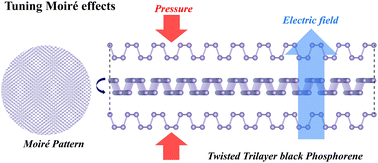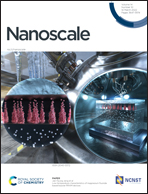Moiré bands in twisted trilayer black phosphorene: effects of pressure and electric field†
Abstract
Twist-induced moiré bands and accompanied correlated phenomena have been extensively investigated in twisted hexagonal lattices with weak interlayer coupling. However, the formation of moiré bands in strongly coupled layered materials and their controlled tuning remain largely unexplored. Here, we systematically study the moiré bands in twisted trilayer black phosphorene (TTbP) and the influences of pressure and electric field on them. Moiré states can form in various TTbPs even when the twist angle is larger than 16° similar to that of twisted bilayer bP. However, different TTbPs show different localization patterns depending on the twisting layer, leading to distinct dipolar behaviors. While these moiré states become quasi-one-dimensional (1D) as the twist angle decreases, external pressure causes the crossover of moiré states from quasi-1D to 0D with a dramatic change in localization areas and greatly reduced bandwidth. Interestingly, compared to twisted bilayer and pristine bP, TTbPs show a much larger electric-field induced Stark effect, controllable by either the twist angle or twist layer. Our work thus demonstrates TTbP as an attractive platform to explore moiré-controlled electronic and optical properties, as well as tunable optoelectronic applications.

- This article is part of the themed collection: 2022 Nanoscale HOT Article Collection


 Please wait while we load your content...
Please wait while we load your content...